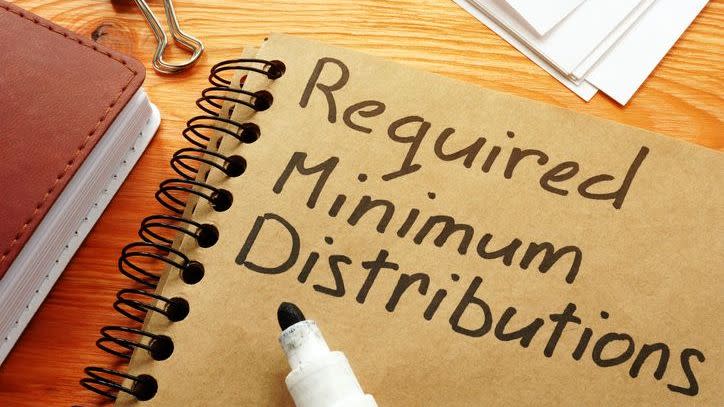
If you’re looking for a tax-savvy way to deal with you required minimum distributions (RMDs), converting them into a Roth IRA isn’t an option.
A financial advisor can help you plan for RMDs and figure out if a Roth conversion is right for you.
It’s relatively common for retirees to need a plan for their required minimum distributions. That’s particularly true for households that don’t need their RMDs to cover living expenses and other spending needs. While you can reinvest these withdrawals in taxable accounts, the IRS restricts how you can fund tax-advantaged accounts like a Roth IRA.
Among those restrictions: you can only make IRA contributions with earned income. As a result, you can’t use RMDs to directly fund a Roth IRA.
What Are RMDs?

Starting at age 73 (or 72 depending on your birthdate), the IRS requires you to begin withdrawing a minimum amount each year from your pre-tax retirement accounts, such as 401(k) plans and IRAs. The exact amount depends on your age and the amount in your portfolio. To calculate your RMD, you divide the portfolio’s balance at the end of the year by a published life expectancy factor.
For any given year that you don’t take the full distribution, the IRS will charge you a tax penalty of either 10% or 25% of the amount that’s not withdrawn. For example, say that you don’t withdraw a required $10,000. You could face a tax penalty of up to $2,500.
The IRS requires you to take RMDs from tax-deferred accounts because each withdrawal is a tax event that triggers income taxes. Since you’ve already paid taxes on the money in Roth accounts, the IRS doesn’t require you to take minimum distributions from them. But if you have additional questions surrounding RMDs, consider speaking with a financial advisor.
Can You Invest RMDs in a Roth IRA?
For some retirees, the problem with a required minimum distribution is that they don’t need the money yet. This comes up, particularly for people who alreasdy sufficient income streams or those who hold multiple accounts and want to draw them down one at a time.
While you have several options for how to manage these distributions, you cannot reinvest them in a Roth IRA.
Roth IRA Requirements
You can only make IRA contributions with what’s called “earned income. This is defined as money that you receive from wages, salary, contract income and other forms of work. You cannot make contributions to an IRA – whether its a traditional or Roth account – from investment proceeds, capital gains or many passive income streams like rental properties.
This means that you’re free to get a job in retirement and put that money into a Roth IRA for later in life. However, you cannot withdraw money from a portfolio and transfer it into a Roth IRA or any other form of tax-advantaged retirement account. The IRS discusses this restriction in full in Publication 590-A.
Conversions Are Also Restricted
This subject can get confusing because of the overlap between a withdrawal and a conversion. When you have a pre-tax portfolio, like a 401(k) or an IRA, you are allowed move money directly into a Roth IRA in what’s called a conversion. You take out a lump sum of money from a tax-deferred account, pay income taxes on the amount and deposit it into the Roth IRA.
However, the IRS specifically prohibits you from converting any required distributions into a Roth IRA. You can convert money that isn’t a required distribution, but the law is unambiguous that you cannot do so with an RMD. Navigating the IRS rules for RMDs and Roth conversions can be confusing, which is way you may want to consider connecting with a financial advisor.
Alternative Options for Roth IRAs and Required Minimum Distributions

So, what should you do instead? For retirees, there are a couple of options for how to manage RMDs.
First, you can convert the rest of your pre-tax portfolio after you meet the RMD requirements. In any year with an RMD, the first dollars you withdraw from that account are treated as part of your RMD. Once you meet the minimum amount, you’re free to convert the rest of your account (in whole or in part) into a Roth.
Say you have a $10,000 RMD in a given year. You first must withdraw that $10,000 before you may convert any remaining, eligible amount in your retirement account to a Roth IRA. As always, when doing so remember that Roth earnings have a five-year cooling-off period, so make sure you won’t need this money right away. And if you withdraw any of the money you convert before the five-year period is up, you could owe a 10% penalty on the money (unless you’re age 59 ½ or older).
Second, it is common for retirees to reinvest their minimum distributions. While you can’t put this money back into a tax-advantaged retirement account, you can put it into a taxable investment portfolio. The exact nature of these investments will vary based on your financial strategy and needs. Some retirees may do well investing for growth, taking money that they don’t need and putting it into equity-heavy funds. Others may do well investing for security, taking money that they will need someday and putting it into bond-heavy funds or annuities.
But if you need additional help reinvesting your RMDs, a financial advisor can help you make a plan to put this money to work for you.
Bottom Line
You cannot reinvest required minimum distributions in a Roth IRA. While you can convert any remaining amount from your pre-tax retirement account, the IRS specifically prohibits you from putting RMD funds in a tax-advantaged portfolio. However, RMDs don’t not need to be the end of your investing. You are free to invest this money in a taxable account as you see fit or convert your remaining IRA or 401(k) funds into a Roth account after your RMD for the year has been met.
Tips on Managing Required Minimum Distributions
-
The RMD formula can be difficult to manage, mostly because the IRS’ “life expectancy factor” can seem very arbitrary on the surface. But figuring out what you will need to withdraw is an important piece of long-term retirement planning puzzle.
-
A financial advisor can help you plan for and manage your RMDs. Finding a financial advisor doesn’t have to be hard. SmartAsset’s free tool matches you with up to three vetted financial advisors who serve your area, and you can have a free introductory call with your advisor matches to decide which one you feel is right for you. If you’re ready to find an advisor who can help you achieve your financial goals, get started now.
Photo credit: ©iStock.com/Fly View Productions, ©iStock.com/designer491, ©iStock.com/SDI Productions
The post I Was Planning on Taking My RMDs and Converting Them to a Roth, But Was Told I Can’t. Is That True? appeared first on SmartReads by SmartAsset.
Source: finance.yahoo.com
